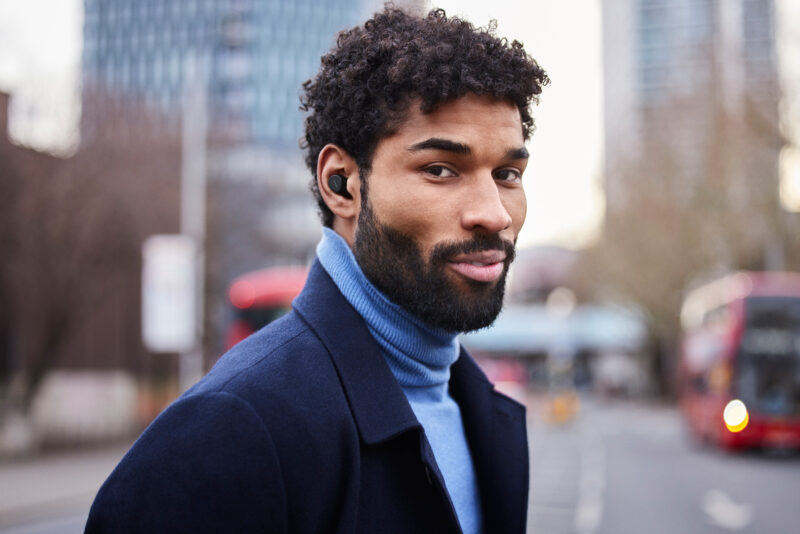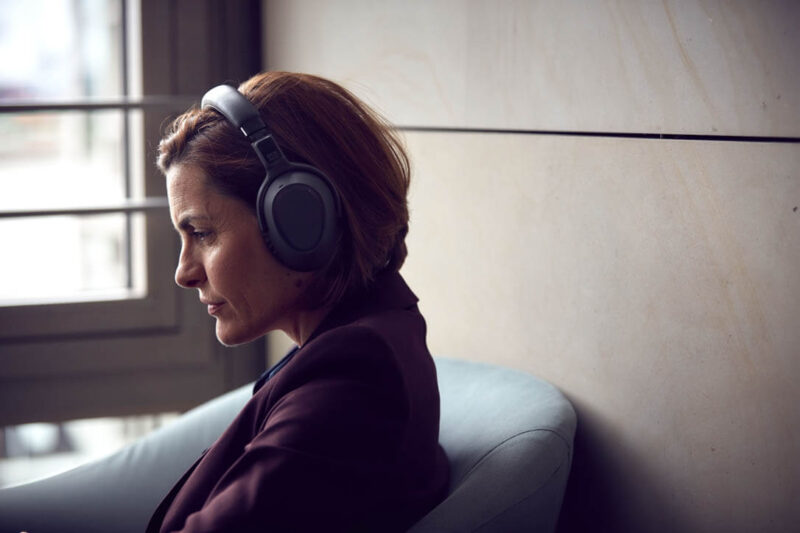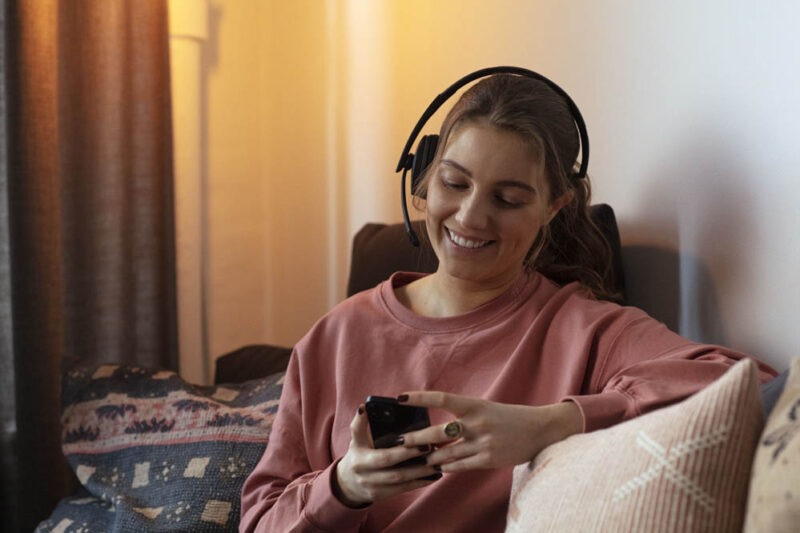Headset Glossary: The A to Z Guide to Headsets

Are you feeling overwhelmed by the jargon surrounding headphones and headsets? Don't worry, you're not alone. With terms like DECT, wireless headsets, VoIP, and Unified Communications, it's easy to get lost in the sea of technical terminology.
That's why we've put together this friendly and knowledgeable headset glossary. Whether you're a beginner or a seasoned audio enthusiast, our comprehensive explanations of common (and not so common terms) will help you understand the ins and outs of the headset world. No more confusion or feeling left out of conversations. Let's dive in and get our headset geek on together!
A
Active Noise-Cancellation (ANC)
Active Noise-Cancellation is a technology that reduces unwanted low-frequency background noise by using an electronic circuit. It works by using microphones to pick up the ambient noise and then generating an opposite sound wave to cancel out the noise. This allows for a quieter and more immersive listening experience, especially in noisy environments such as aeroplanes or busy city streets. Active noise cancellation only works with stereo headsets (that is headsets that cover both ears).
Analog
Analog refers to a mechanism that represents data using a continuously changing variable, typically a voltage that tracks and represents sound pressure level. In the context of headphones, analog signals are used to reproduce sound waves in a continuous and smooth manner, capturing the nuances and details of the audio signal. Analog headphones are known for their warm and natural sound reproduction, providing a more organic listening experience.

B
Behind-the-neck Headset
Behind-the-neck headsets, also known as neckband headsets, have a headband that fits behind the neck instead of over the head. These headphones are popular for active use and exercise since they provide stability during movement. They are also preferred by those who want to avoid messing up their glorious hair or for people who are wearing hats or helmets. The behind-the-neck design offers a comfortable and secure fit, allowing users to enjoy their music or make calls without the headphones slipping off.
Binaural Headset
A binaural headset, most often referred to as a stereo headset, is a style of headset that has speakers for both ears, providing a stereo audio experience. These headsets offer the user a greater degree of caller focus, as the sound is delivered separately to each ear. By reproducing audio in both ears, binaural headsets create a more immersive and realistic listening experience. They are commonly used in work environments where focus is a priority, as they block out the most external noise due to covering (or inserted into) both ears.
Bluetooth
Bluetooth is a wireless communication protocol that allows for seamless connectivity between various devices. It was developed by a consortium of industry leaders and enables wireless transmission of data and audio signals over short distances. Bluetooth headsets utilise this technology to connect wirelessly to smartphones, tablets, and other compatible devices, providing hands-free communication and audio streaming convenience. Bluetooth headsets have become increasingly popular due to their ease of use and compatibility with a wide range of devices.

Bone Conduction Headset
Bone conduction headsets are a unique type of headset that does not sit on or in the ears like traditional headphones. Instead, they rest on the temples and transfer sound via vibrations on the skull bone. This technology allows sound to be transmitted directly to the inner ear, bypassing the outer and middle ear. Bone conduction headsets are often used by individuals with hearing loss or those who prefer to keep their ears open to hear their surroundings while listening to audio.
Boom Microphone
A boom microphone is a type of microphone that is held in a fixed position from the mouth by an arm or boom, which is the most traditional headset mic. It offers several advantages over a fixed desktop microphone, especially in situations where the user's head moves around. As the user moves their head, the boom microphone maintains a consistent distance from the mouth, ensuring a constant volume for the caller. This makes it ideal for hands-free communication in professional settings and provides clearer and more consistent voice transmission.
Busy Light
A busy light is a convenient feature that allows you to indicate your availability during phone calls or conferences. It is typically a visible light that can be easily noticed by others around you. The purpose of a busy light is to minimise interruptions and provide a visual cue to colleagues or family members that you are engaged in a conversation or busy with work. This can be especially useful in open office environments or shared spaces where it may be difficult for others to determine if you are on a call. The busy light can be used with or without a headset and can be purchased separately as an accessory.

C
Circum-aural Headsets
Circum-aural headsets, often referred to as over-ear headsets, are designed with earcups that completely enclose or cover the ears. The term "circum-aural" derives from the Latin words "circum" meaning "around" and "auris" meaning "ear," indicating that these headphones fit around the ear. They are known for their large earpads that provide a comfortable fit and create a seal around the ear, effectively isolating the listener from external noise. The closed-back design of circum-aural headphones helps to contain the audio within the ear cups and prevents sound leakage. These headphones are popular among audiophiles, studio professionals, and individuals who prioritise immersive audio experiences.
Closed-back Headphones
Closed-back headphones, also known as sealed-back headphones, are designed to block out external noise by utilising a passive acoustic seal. Unlike open-back headphones that allow sound to escape and external noise to enter, closed-back headphones feature solid ear cup shells that create a barrier between the listener and the surrounding environment. This design significantly reduces sound leakage and provides better sound isolation, resulting in a more immersive audio experience. Full-size closed-back headphones offer a moderate level of noise isolation, typically around -10dB to -15dB, while smaller on-ear closed-back headphones provide slightly less isolation. In-ear headphones, which also fall under the closed-back category, provide the highest level of isolation, blocking approximately -25dB or more of outside noise. Noise-cancelling headphones, a type of closed-back design, incorporate electronic circuitry to further attenuate ambient noises, surpassing the isolation achieved by passive ear cup sealing.
Convertible Headset
A convertible headset is a versatile headset style that can be quickly reconfigured to be worn in different ways. Typically, a convertible headset can be worn either as an over-the-head model or converted to an on-the-ear style. This adaptability allows users to customise their wearing preference based on comfort and practicality. Some convertible headsets offer additional configurations, such as a behind-the-neck style, providing users with even more flexibility in finding the most suitable wearing option for their needs. Convertible headsets are popular in professional environments where individuals may require different wearing styles for various tasks or preferences.

D
dBr
In audio measurements, "dBr" stands for Decibels relative, and it is often used to represent the amplitude or level of sound signals relative to each other. On a frequency response graph, the amplitude in dBr is typically listed on the Y-axis, indicating the magnitude of each frequency's response relative to the amplitude of other frequencies in the same measurement. It is important to note that dBr values are not absolute decibel measurements but rather represent the relative differences between frequencies in the given context.
DECT
DECT (Digital Enhanced Cordless Telecommunications) is a digital wireless technology initially developed in Europe and now adopted worldwide for various applications, including cordless telephones, wireless offices, and even wireless telephone lines to homes. DECT technology offers advantages such as improved call clarity and enhanced security for headsets that utilise this standard. It has been designed and specified to be more compatible with other wireless technologies, reducing interference and ensuring reliable communication. DECT wireless headsets are widely used in professional settings, call centres, and home offices, providing users with the freedom to move around while staying connected to their communication devices. DECT is often compared to Bluetooth, but there are differences between the two types of wireless technologies.
Driver
The driver in a headphone refers to the component responsible for converting electrical signals into sound waves that can be heard by the listener. Most headphones employ dynamic drivers, which consist of a coil of wire suspended in a magnet and attached to a diaphragm, similar to a miniature speaker cone. When an electrical signal passes through the coil, it creates a magnetic field that interacts with the magnet, causing the diaphragm to vibrate and produce sound. Other types of drivers used in headphones include planar magnetic and electrostatic drivers, each with its unique design and sonic characteristics. The driver plays a crucial role in determining the overall sound quality, frequency response, and efficiency of a headphone.

E
Earbud
Earbud headphones are the compact headphones commonly included with portable music players or smartphones. They are designed with small earpieces that rest in the concha, the cupped area around the outer entrance of the ear canal. Unlike in-ear headphones, which create a seal within the ear canal, earbuds rest in the concha and do not provide the same level of noise isolation. While earbuds come in similar sizes, they should not be confused with in-ear headphones as the latter typically provide better sound quality and isolation. Some earbuds may feature attachments or ear clip designs to improve stability during wear. Earbuds are convenient for casual listening and on-the-go use, although they may not offer the same audio fidelity and noise isolation as other headphone types.
Earpads
Earpads, also commonly referred to as ear cushions, are replaceable foam or cushioned components designed for headsets that cover or rest on the ears. These essential accessories serve multiple purposes, allowing users to customise their headset for optimal comfort and personal style while enhancing the overall wearing experience. Earpads are crafted from soft, cushioning materials that not only provide a comfortable layer between the headset's speakers and the ears but also help in creating a secure and cozs fit. These pads serve as a barrier that prevents the hard surfaces of the headset from coming into direct contact with the sensitive skin of the ears, mitigating discomfort during prolonged use.

Earphones
Earphones, often referred to as in-ear headphones, are a type of headphone that is inserted into the ear canal, similar to wearing earplugs. They provide the highest level of noise isolation among all headphone types, including noise-cancelling headphones. Earphones are designed to create a tight seal within the ear canal, blocking out external sounds and immersing the listener in their audio. There are two main types of in-ear headphones: deep-sealing and shallow-sealing. Deep-sealing in-ear headphones insert the earphone tip approximately halfway into the length of the ear canal, securing it within the bony section. These types of earphones can provide noise isolation of around -23dB or more. Shallow-sealing in-ear headphones seal closer to the entrance of the ear canal, providing approximately -15dB of noise isolation. Earphones are highly portable, lightweight, and ideal for on-the-go use.
EPOS
EPOS Sennheiser is a reputable brand that specialises in the production of high-quality headsets. With a commitment to delivering exceptional audio experiences, EPOS designs and manufactures headsets that cater to a diverse range of users, including professionals, gamers, and audio enthusiasts. EPOS headsets are crafted with meticulous attention to detail, incorporating advanced audio technologies, ergonomic designs, and durable construction. Whether it's for business communication, immersive gaming sessions, or enjoying your favourite music, EPOS headsets offer impressive sound reproduction, clear microphone performance, and comfortable wearing options. With their focus on innovation and user-centric design, EPOS continues to establish itself as a leading brand in the headset market, providing reliable and immersive audio solutions for a variety of applications.
EHS Cable
An Electronic Hookswitch (EHS) cable is a communication accessory used in conjunction with compatible telephone systems and headsets. It serves the same purpose as a handset lifter, enabling remote call answering and ending through the headset. However, unlike a physical lifter, an EHS cable utilises digital signals to control the telephone system and manage call functions. The EHS cable connects the headset's control module to the telephone system's electronic interface, facilitating seamless call control without the need for manual handset lifting. It provides a convenient and efficient solution for hands-free communication and call management in professional environments.

F
Frequency Response
Frequency response refers to the range of frequencies that a headphone or audio system can reproduce accurately. It represents the system's gain or output level at various frequencies. A "flat" frequency response means that the gain or output level is consistent across all frequencies, resulting in a balanced and accurate sound reproduction. For example, if a headphone has a gain of two (2) at both 20 Hertz and 20 kilohertz, with a consistent gain at all frequencies in between, it would be considered to have a flat frequency response. A wide and flat frequency response is desirable for headphones, as it allows for faithful reproduction of the entire audio spectrum, ensuring accurate representation of low, mid, and high-frequency sounds.
Full-size headphones
Full-size headphones, also known as circum-aural or over-ear headphones, feature large ear cups that completely cover the earlobes. They are designed to enclose the ears fully, creating a seal that helps to block out external noise and provide an immersive listening experience. Full-size headphones are favoured by many audiophiles and professionals due to their ability to deliver excellent sound quality and comfort for extended periods. The larger earcups allow for spacious sound reproduction and typically accommodate larger drivers, which can contribute to a more accurate and dynamic audio performance. Full-size headphones are often used in studio monitoring, critical listening, and immersive audio applications where audio fidelity and isolation are paramount.
G
GN Netcom
GN Netcom is a subsidiary of GN Danavox, a Danish company. Over the years, GN Netcom has acquired several smaller headset manufacturers, including Unex, ACS, Jabra, and others. GN Netcom specialises in the production of high-quality headsets and related communication solutions. Their product lineup includes a wide range of wired and wireless headsets for professional use, such as call centres, offices, and personal communication devices. GN Netcom headsets are known for their durability, comfort, and advanced features that enhance productivity and communication clarity.

H
Handset
The handset is the part of a telephone system that users pick up and hold to their ear to communicate. It consists of a receiver (earpiece) for listening and a microphone for speaking. When a user lifts the handset from its cradle, it establishes a connection and enables two-way communication. The design and functionality of handsets can vary across different telephone systems and models, but they generally serve as the primary interface for voice communication.
Handset Lifter
A handset lifter is a simple device used with telephone systems and headsets. It automatically lifts the telephone receiver (handset) from its cradle when a call is answered using a headset. The lifter securely holds the line open, allowing the user to converse through the headset without the need to manually lift the handset. A handset lifter is a practical accessory for reducing desktop clutter and improving convenience, particularly in busy office environments or call centres. It enables hands-free communication, enhances productivity, and allows users to answer calls remotely without physically interacting with the telephone handset.
Headphones
Headphones are audio devices that are worn over the ears to listen to sound privately. They consist of two speakers (also known as drivers) that produce sound directly into the ears of the user. Headphones do not have a built-in microphone and are primarily used for listening to music, audio, or other forms of sound. They come in various designs, including over-ear, on-ear, and in-ear styles, catering to different preferences and applications. Headphones offer a personal and immersive listening experience by isolating the listener from external noise and delivering high-quality audio reproduction.
Headset
A headset is a combination of headphones and a built-in microphone, allowing users to listen to audio and communicate with others simultaneously. It is designed for applications that require both listening and speaking functions, such as telephony, gaming, video conferencing, and voice chat. The microphone in a headset enables clear voice capture, facilitating two-way communication. Headsets come in different styles, including over-ear, on-ear, and in-ear configurations, providing users with options that suit their comfort and audio requirements. They are widely used in professional environments, call centres, and for personal use, offering convenience and hands-free communication capabilities.
Headset Base
A headset base refers to the charging base or amplifier that accompanies a wireless or wired headset system. It serves as a docking station for wireless headsets, allowing them to charge when not in use. The base may also include additional features such as audio controls, connectivity options, and indicators for battery status or call status. In the case of a wired headset, the base can act as an amplifier, providing power and signal amplification to enhance audio quality and control settings. The headset base is an essential component of a headset system, providing convenient storage, charging, and additional functionalities.
Headset Port
A headset port is a specific audio interface found on some telephones and communication devices. It enables the connection of headsets directly to the device, allowing users to utilise the headset's microphone and headphones for audio communication. The headset port can have different physical connectors, such as a round 2.5 mm plug or a square modular RJ9 plug. However, it is worth noting that some headset models, particularly those from Plantronics, are designed to connect to the telephone's hand receiver port rather than the headset port. The availability and compatibility of a headset port depend on the specific phone or device model.

I
In-Ear Headset
An in-ear headset, also known as earbud-style headphones, is a type of headset that utilises intra-aural speakers. In-ear headsets feature small earpieces that sit gently inside the ear canal, providing a compact and lightweight design. They offer a convenient and portable audio solution, making them popular for everyday use and active lifestyles. In-ear headsets are known for their ability to provide a snug fit and seal the ear canal, which helps to reduce external noise and improve audio isolation. This type of headset typically offers good sound quality and isolation, making it suitable for various applications such as listening to music, podcasts, or making phone calls.
In-Ear Monitor
In-ear monitors (IEMs), also referred to as ear canal headphones, earphones, or canal-phones, are a type of in-ear headset specifically designed for professional audio monitoring purposes. They are commonly used by musicians, sound engineers, and stage performers to monitor their live audio performance with high fidelity and precise sound reproduction. In-ear monitors offer exceptional noise isolation by sealing the ear canal, which minimises ambient sound interference and allows the user to focus on the desired audio. They come in different designs, including deep-sealing and shallow-sealing types, offering varying levels of isolation. In-ear monitors are known for their accuracy, detail, and the ability to reproduce a wide frequency range, making them a preferred choice for professionals who require precise audio monitoring.

Inline Volume Control
An inline volume control is a feature found on the cord of a headset or headphones, allowing users to adjust the volume level conveniently and quickly. It provides easy access to volume adjustments without the need to reach for an external volume control or device. The inline volume control typically consists of buttons or a slider that can be operated with one hand, allowing users to increase or decrease the volume to their desired level. This feature offers convenience and flexibility, enabling users to personalise their audio experience without interrupting their activities or accessing external volume controls.
Intra-aural headset
Intra-aural refers to a type of speaker or audio device that sits gently inside the ear canal. Intra-aural speakers, commonly used in in-ear headphones or in-ear monitors, are designed to deliver sound directly into the ear canal, providing a close and immersive audio experience. They are typically small, lightweight, and fit comfortably inside the ear, offering convenience and portability. Intra-aural speakers provide a focused and localised sound delivery, allowing users to hear audio with clarity and detail. This type of speaker is known for its ability to provide good noise isolation and accurate sound reproduction, making it popular for personal audio listening and professional audio applications.
Isolation
Isolation, in the context of headphones, refers to the ability of a pair of headphones to block or reduce outside ambient sounds, enabling the listener to hear the audio from the headphones more clearly. It is a measure of how effectively the headphones can isolate the listener from the surrounding environment. Isolation can be quantified as a broad-band reduction in amplitude, typically measured in decibels (dB), or represented graphically to indicate the amount of attenuation across the audio spectrum. Headphones with good isolation are capable of reducing external noise, allowing for an undisturbed listening experience and enhanced audio immersion. Isolation is particularly important in noisy environments or when privacy and focus are desired during audio playback or communication.

J
Jabra
Jabra is a well-known brand specialising in the production of headsets and audio solutions. They offer a wide range of headsets designed for various purposes, including communication, music listening, and professional use. Jabra headsets are recognised for their high-quality sound reproduction, comfort, and advanced features such as noise cancellation and wireless connectivity. Whether for personal or business use, Jabra provides reliable and innovative headset options to meet different audio needs.
K
Key Lock
Key Lock is a useful feature found in many headsets that allows users to lock the controls or buttons to prevent unintentional adjustments or changes to settings. By activating the Key Lock, you can ensure that the headset remains in its current state, preserving your preferred settings and preventing any accidental disruptions. This feature is particularly handy during active use or while on the go, as it prevents buttons from being pressed or controls from being accidentally triggered when the headset is in your pocket or bag. Whether you're enjoying your favourite music or engaged in an important conversation, the Key Lock function adds an extra layer of convenience and peace of mind, allowing you to focus on your audio experience without worrying about unintentional interruptions or changes.
KHz (Kilohertz)
KHz, short for Kilohertz, is a unit of measurement used to specify the range of audio frequencies that a headset or headphone can reproduce. It represents the number of complete audio cycles per second. In the context of headsets, a wider frequency range generally indicates the ability to reproduce a broader spectrum of sounds, resulting in more detailed and accurate audio reproduction. Higher KHz values typically mean a wider frequency response, enabling the headset to deliver clearer high-frequency sounds such as crisp vocals, cymbals, or other high-pitched instruments. However, it's important to note that the overall sound quality also depends on other factors such as the driver quality, audio codec, and the headphones' design. When comparing headsets, considering the KHz range can provide insights into their potential audio performance and suitability for different types of content, whether it's immersive gaming, music production, or enjoying movies and multimedia.
L
Listening Fatigue
Listening fatigue refers to the tiredness or discomfort experienced by individuals when listening to audio for extended periods, particularly in artificial listening environments like headphones and speakers. It occurs when the brain has to constantly work to accurately locate and process sounds in a two-dimensional space, which can be challenging compared to natural listening conditions. Listening fatigue is often more pronounced when using headphones due to the close proximity of the sound source to the ears. However, this issue can be alleviated by utilising technologies like the HeadRoom crossfeed circuit, which helps to recreate a more natural soundstage and reduce the strain on the brain. By minimising listening fatigue, individuals can enjoy prolonged listening sessions without experiencing excessive tiredness or discomfort.

M
Microsoft Teams Certified
When a headset is Microsoft Teams Certified, it signifies that the headset has undergone specific testing and meets the standards set by Microsoft for seamless integration and optimal performance with the Microsoft Teams platform. These certified headsets are designed to provide a superior audio experience during Teams meetings and calls.
In addition to meeting the audio quality and performance requirements, Microsoft Teams Certified headsets often come with additional features tailored for Teams users. One such feature is a dedicated button on the headset that allows users to easily launch the Microsoft Teams application or answer calls with a single press. This streamlines the user experience, enabling quick access to Teams functionalities without having to navigate through the software interface.
By choosing a Microsoft Teams Certified headset, users can enjoy enhanced audio clarity, reliable call connectivity, and advanced features that seamlessly integrate with Microsoft Teams. These headsets undergo rigorous testing to ensure compatibility and optimize the audio experience for Teams users, whether they are participating in video conferences, collaborating remotely, or engaging in team discussions.
Monaural headset
Monaural, also known as a mono headset, refers to a type of headset that features a single speaker. Unlike stereo headsets that provide separate audio channels for each ear, monaural headsets deliver sound through a single speaker. This design is commonly used in applications where mono audio playback is sufficient, such as phone conversations or certain professional uses. Monaural headsets are often chosen for their simplicity, lightweight design, and cost-effectiveness. They are suitable for tasks that do not require stereo sound reproduction, allowing users to focus on the audio content while keeping one ear open to the surrounding environment.
Mono headset
A mono headset, also referred to as a monaural headset, is a type of headset that utilises a single speaker to deliver audio. This design is commonly used in applications where mono audio playback is adequate, such as telephone conversations or certain professional settings. Mono headsets provide a simple and straightforward audio solution, featuring a lightweight and compact design. They are often preferred in scenarios where it is necessary to keep one ear available for external sounds or conversations while maintaining clear communication or audio reception.
N
Noise-cancelling
Noise-cancelling refers to a microphone design that effectively reduces or eliminates the transmission of background noise. This feature is commonly found in headsets and allows for clearer and more intelligible communication, particularly in noisy environments. By implementing advanced signal processing techniques, noise-cancelling microphones can analyse and differentiate between desired speech and unwanted ambient noise. They then generate an inverse sound wave to cancel out the background noise, resulting in enhanced audio clarity for both the speaker and the listener. Noise-cancelling microphones are valuable in various applications, such as call centres, office environments, or any situation where clear communication is crucial. They help to minimise distractions and improve the overall sound quality of the headset.

O
Omni-Directional
Omni-directional refers to a microphone's capability to receive sounds equally from all directions. Unlike directional microphones that are more focused on capturing sound from specific angles, omni-directional microphones are designed to pick up sounds from all around them. This makes them suitable for recording situations where capturing ambient sounds or a broader audio environment is desired. Omni-directional microphones are commonly used in scenarios such as conference calls, interviews, or recording live performances, where capturing a natural and immersive audio experience is important.
On-ear Headset
An on-ear headset is a type of headset that rests on the ears rather than fully encompassing them. These headsets typically have smaller ear cups that sit directly on the ears, providing a comfortable and lightweight listening experience. On-ear headsets are designed to be portable and offer a balance between portability and audio performance. They are a popular choice for users who prefer a more compact design and do not want the ear cups to completely cover their ears. On-ear headsets provide good sound quality and isolation from external noise, while still allowing some awareness of the surrounding environment.
Open Back Headphones
Open-back headphones feature ear cups that have an open or vented back design. Unlike closed-back headphones that have sealed ear cups, open-back headphones allow sound to leak out of the ear cups and also permit ambient sounds to enter the headphones. This design creates a more natural and spacious sound experience, resembling listening to speakers in a room rather than having sound isolated inside the headphones. Open-back headphones offer a wider soundstage, providing a sense of depth and distance in the audio. They are favoured by audiophiles and critical listeners who prioritise a more accurate and immersive sound reproduction.
Output Impedance
Output impedance refers to the effective resistance seen by a load when looking back into the output of an amplifier. It measures how much the amplifier impedes the flow of energy to the connected load. For headphone amplifiers, a lower output impedance is desirable as it allows for better damping control over the headphones. When the output impedance of an amplifier is low, it can more effectively control the movement of the headphone drivers, resulting in improved audio accuracy and reduced distortion. Solid-state headphone amplifiers typically have an output impedance of around one Ohm, providing optimal performance and compatibility with a wide range of headphones.
Over-ear Headset
An over-ear headset refers to a type of headset that covers the entire ear, providing a secure and comfortable fit. It features earcups that fully enclose the ears, effectively sealing off external noise and creating an immersive listening experience. Over-ear headsets are popular in gaming, multimedia, and communication settings where noise isolation and audio clarity are essential. They offer improved sound quality, deep bass response, and a more immersive audio experience compared to on-ear or in-ear headsets. Over-ear headsets often come equipped with built-in microphones and adjustable headbands for a customised and comfortable fit during extended use.
Over-the-Head Headset
An over-the-head headset is the most common style of headset design, characterised by a headband that goes up and over the wearer's head. This style ensures a secure and comfortable fit by distributing the weight of the headset evenly across the head. Over-the-head headsets are available in both monaural (single speaker) and binaural (dual speaker) configurations. They are widely used in various applications, including call centres, offices, and gaming, as they provide a reliable and comfortable option for extended wear. The over-the-head design allows for easy adjustment and positioning of the speakers to align with the ears, ensuring optimal sound delivery and clear communication.

P
Passive Noise Cancelling
Passive noise cancelling is a technique used in headphones or headsets that relies on the physical properties of the device, such as the design and seal of the earcups, to block out incoming noise. By creating a tight seal around the ears, passive noise cancelling headphones prevent external sounds from entering the earcups and interfering with the audio experience. The closed-back design and quality materials used in the construction of these headphones contribute to their ability to attenuate ambient noise. Unlike active noise cancelling, which uses electronic circuitry to actively eliminate background noise, passive noise cancelling works purely through the physical design of the headphones. This makes passive noise cancelling headphones a more affordable option while still providing effective noise isolation, particularly in environments with moderate levels of ambient noise.
Plantronics
Plantronics is a reputable and well-known manufacturer of headsets and audio communication solutions. With a strong presence in the market, Plantronics offers a wide range of headsets designed for various applications, including call centres, offices, and personal use. Their products are known for their quality, durability, and advanced features that enhance communication and audio experiences. Plantronics headsets are often praised for their clear audio reproduction, comfortable fit, and reliable performance. Whether for professional use or personal enjoyment, Plantronics offers a diverse selection of headsets to meet the needs of different users.
Poly
Poly refers to the collaboration between Polycom, a global communications company, and Plantronics. In 2019, Plantronics rebranded itself as Poly to reflect its expanded portfolio of audio and video communication solutions. The collaboration between Poly and Plantronics combines their expertise in the field of audio communications to deliver innovative and high-quality headsets under the Poly/Plantronics brand. Poly headsets continue the legacy of Plantronics, offering reliable performance, advanced features, and excellent audio quality for various professional and personal communication needs.

Q
Quick Adjust
Quick Adjust is a feature found in headsets that includes a telescopic microphone boom. This adjustable boom allows users to position the microphone in the optimal location for clear speech recognition and improved sound quality during conversations. With Quick Adjust, users can easily extend or retract the microphone boom to find the perfect distance and angle relative to their mouth. This feature ensures that the microphone captures the user's voice accurately, reducing background noise and enhancing the clarity of communication. Whether in a busy office environment or a gaming session, Quick Adjust enables users to customise the microphone position for optimal performance and convenience.
Quick Disconnect
Quick Disconnect is a small connector integrated into the cord of a headset. This connector allows users to disconnect quickly from a call or audio source without putting the caller on hold or disrupting the conversation. With Quick Disconnect, users can simply detach the headset from the cord by unplugging the connector, providing freedom of movement and flexibility. This feature is particularly beneficial in office environments where users may need to move around while remaining connected or when they need to step away from their desks briefly. Quick Disconnect enables seamless transitions and convenient mobility without interrupting the conversation or audio playback.
R
Reversible Headset
In the context of headsets, reversible refers to a headset design that allows the user to wear the speaker on either the left or right ear. Unlike convertible headsets that can be transformed to be worn on either ear, reversible headsets are designed with a specific orientation but can be adjusted easily for left or right ear use. This flexibility ensures that users can adapt the headset to their preferred side and maximise comfort during extended periods of use. By offering the option to switch the speaker orientation, a reversible headset accommodates personal preferences and provides a customisable fit, catering to the comfort and convenience of the user.

S
Sealed Headphones
Sealed headphones, also known as "closed-back" headphones, are designed to block out ambient noise by utilising a passive acoustic seal. These headphones feature ear cups with a closed construction that limits the passage of sound in and out of the headphones. The seal created by the closed-back design helps isolate the listener from external noise, providing a more immersive and focused audio experience. Full-size closed headphones offer around -10dB to -15dB of noise isolation, primarily in the higher frequency range. On-ear closed headphones provide varying levels of isolation depending on their design and the shape of the user's ears. In-ear headphones, which are also sealed designs, offer the highest level of isolation among headphone types, as they create a tight seal within the ear canal, resulting in approximately -23dB of attenuation. Noise-cancelling headphones often employ a sealed design with additional active electronic components to further reduce ambient noise, surpassing the isolation achieved by passive closed-back headphones.
Sennheiser
Sennheiser is a renowned German company recognised for its excellence in manufacturing microphones, headphones, and telephone headsets. With a rich history spanning several decades, Sennheiser has established itself as a leading brand in the audio industry. Sennheiser headsets and headphones are especially renowned for their audio quality and engineering. The company is known for its commitment to delivering high-quality audio products that cater to a wide range of applications and user preferences. Sennheiser's product lineup includes a diverse range of microphones, headphones, wireless systems, and audio accessories, all crafted with meticulous attention to detail and sound engineering expertise. Whether it's professional-grade microphones for studio recording, wireless headphones for audiophiles, or communication headsets for business and personal use, Sennheiser products are renowned for their exceptional audio performance, durability, and innovative features. As a trusted brand, Sennheiser has garnered a strong reputation among professionals, musicians, audio enthusiasts, and everyday users alike.
SoundGuard
SoundGuard™ is a proprietary technology developed by Plantronics, specifically the SoundGuard Plus™ implementation, which ensures optimal audio clarity and protection in call centre environments. It is designed to prevent sudden loud sounds from causing discomfort or harm to the user's hearing. SoundGuard Plus™ swiftly reduces the volume of loud tones and effectively limits any transient "pops" that may occur during calls. The primary objective of SoundGuard Plus™ is to maintain the natural and unchanged quality of the human voice, enabling clear and intelligible communication in the call centre environment. By employing advanced audio processing techniques, SoundGuard Plus™ creates a comfortable and productive communication environment, ensuring that important conversations are easily understood and that the voice quality remains consistent.
Standby-Time
Standby time refers to the duration that a headset or device can remain in a power-saving mode, conserving energy while not actively in use. It is the period during which the device remains operational but idle, ready to receive calls or perform functions without being actively engaged. Standby time is particularly relevant for wireless headsets or cellular phones, as it determines how long the device can remain in a standby mode before requiring a recharge or power source. It is important for users who may need to keep their headset available for extended periods, even if they are not actively using it. A longer standby time provides greater flexibility and convenience, allowing users to keep their headsets powered on and ready for use throughout the day without the need for frequent recharging.
Stereo Headset
A stereo headset, also known as a binaural headset, is a type of headset that features speakers positioned on both ears. This configuration enables the headset to reproduce audio in stereo, with separate channels for the left and right ears. Stereo headsets offer a more immersive and realistic sound experience compared to mono-aural headsets, where the sound is played through a single speaker. By providing distinct audio channels for each ear, stereo headsets deliver better spatial imaging and localisation of sound sources, enhancing the perception of depth and positioning in the audio playback. Whether used for music listening, gaming, or communication, stereo headsets provide a more engaging and enjoyable audio experience, allowing users to fully appreciate the stereo separation and detailed sound reproduction in their multimedia content.
Supra-aural Headset
Supra-aural headsets, also referred to as on ear headsets, are designed to rest on the outer ear rather than fully enclosing or surrounding it. The earpieces of supra-aural headphones are typically flat pads or shallow bowl-shaped structures that make direct contact with the outer ear. Unlike circumaural headphones that fully envelop the ear, supra-aural headphones offer a lighter and more breathable design, making them comfortable for extended listening sessions. The smaller ear cups of supra-aural headphones are positioned against the ears, providing a more open sound experience compared to closed-back or in-ear headphones. While they may not provide the same level of noise isolation as circumaural headphones, supra-aural headphones are valued for their portability, compactness, and the ability to allow some ambient sound to reach the ears. They are a popular choice for individuals who prefer a more relaxed fit and a sound signature that maintains some awareness of the external environment.

T
Talk-time
Talk-time refers to the duration or number of hours that a headset can be used for voice communication before it needs to be recharged. It represents the battery life or power capacity of the headset to sustain active conversations. Talk-time is a crucial specification for wireless headsets, as it determines how long users can engage in phone calls or voice chats without the need to connect the headset to a power source. A longer talk-time ensures uninterrupted communication and reduces the frequency of recharging, allowing users to have extended conversations or use the headset throughout the day without worrying about battery depletion. Talk-time is often indicated by the manufacturer and can vary depending on the headset model, battery capacity, and usage patterns. It is an essential consideration for individuals who rely on their headsets for frequent and prolonged voice communication, such as call centre agents, professionals working remotely, or individuals who frequently make phone calls on the go.
Training Cable
A training cable is a device that enables two headsets to connect to a single phone or audio source. It is particularly useful in training scenarios where supervisors or trainers need to monitor and listen in on trainees' conversations. By using a training cable, supervisors can provide real-time guidance, feedback, and coaching to trainees, helping them improve their skills and quickly get up to speed. This adapter cable allows for effective training and ensures that supervisors can closely monitor trainee performance without the need for additional equipment or complicated setups. Training cables are available as separate accessories and can be easily connected to compatible headsets and phones, making them a valuable tool in professional training environments.
U
UC
UC stands for Unified Communications, which refers to a technology that integrates various communication platforms into a single system. With a UC-enabled headset, you can connect to multiple devices such as telephones, PCs, and even mobile phones. This integration allows you to seamlessly switch between different communication channels and devices, streamlining your workflow and enhancing productivity. A UC headset often comes equipped with features like call control buttons, inline controls, and connectivity options that enable easy switching between different communication modes. Whether you need to make phone calls, participate in video conferences, or use voice applications on your computer, a UC headset provides a unified solution that simplifies communication and enhances efficiency.
USB
USB, which stands for Universal Serial Bus, is a widely used standardised interface that facilitates connectivity between electronic devices and computers. Originally designed as a peripheral control interface for personal computers, USB has become ubiquitous and is now found in various devices ranging from gaming consoles to handheld portable devices. It allows for the easy connection and communication of devices with computers, enabling data transfer, device charging, and peripheral control. USB ports are commonly found on computers, laptops, and mobile devices, providing a versatile and convenient way to connect devices such as external hard drives, keyboards, mice, printers, and, in this case, headsets. The USB standard is governed by the USB Implementer Forum, which is a consortium of industry leaders working together to ensure compatibility and standardisation across different devices and platforms.
V
VoIP
VoIP, or Voice over Internet Protocol, is a technology that enables voice communication over the internet instead of traditional phone lines. With VoIP, you can make voice and video calls, send messages, and conduct conferences using internet connections. VoIP technology converts voice signals into digital data packets that are transmitted over the internet in real-time, allowing for cost-effective and flexible communication. By utilising VoIP, individuals and businesses can enjoy the benefits of enhanced communication features, scalability, and reduced costs compared to traditional telephone systems. VoIP headsets are specifically designed to work seamlessly with VoIP applications, providing clear audio transmission, noise cancellation, and integration with communication software, ensuring high-quality voice communication over the internet.

W
Wireless Headset
Wireless headsets have gained popularity in recent years due to the convenience and freedom they offer. These headsets utilise wireless technologies such as Bluetooth to establish a connection with audio sources like smartphones, tablets, or computers, eliminating the need for physical cables. Wireless headsets provide the flexibility to move around freely without being tethered to a device, making them ideal for activities like exercising, gaming, or hands-free communication. They offer convenience and comfort, as there are no cables to get tangled or restrict movement. However, it is essential to consider factors such as battery life, audio quality over wireless connections, and potential latency issues when choosing a wireless headset. With advancements in wireless technology, modern wireless headsets can provide reliable and high-quality audio performance, allowing users to enjoy seamless and wire-free audio experiences.
Y
Yealink
Yealink is a respected brand that specialises in the development and manufacturing of communication devices, including headsets. Yealink headsets are designed to provide reliable and high-quality audio experiences for various communication platforms, such as VoIP phones, unified communications systems, and video conferencing solutions. Known for their ergonomic design, durability, and compatibility with different devices, Yealink headsets offer users comfortable and efficient communication experiences. Whether for professional use in office environments or personal use at home, Yealink headsets are trusted for their excellent audio performance and user-friendly features.
X
XLR Connector
The XLR connector is a type of electrical connector commonly used in professional audio equipment, including headsets and microphones. It features a circular design with three pins inside a metal housing, providing a secure and reliable connection. XLR connectors are known for their balanced audio transmission, which helps minimise interference and ensures high-quality audio signals. They are often used in professional settings, such as recording studios, live performances, and broadcasting, where reliable and noise-free audio connections are crucial. XLR connectors are designed to be sturdy and lock securely into place, preventing accidental disconnections during critical audio applications. They are widely recognised as a standard connection type in the audio industry and are compatible with a variety of audio devices, including headsets and microphones.
Z
Zoom Certified
Zoom Certified headsets are specifically tested and approved for use with the Zoom video conferencing and communication platform. When a headset is Zoom Certified, it means it has met the standards and requirements set by Zoom for optimal audio performance during Zoom meetings and calls.
A Zoom Certified headset guarantees compatibility and seamless integration with the Zoom platform. These headsets undergo thorough testing to ensure they provide clear and intelligible audio, reliable connectivity, and advanced features that enhance the Zoom experience. By using a Zoom Certified headset, users can expect high-quality audio, minimized background noise, and a comfortable communication experience.
Whether for business meetings, remote collaboration, webinars, or virtual events, a Zoom Certified headset is designed to deliver superior audio performance and ensure clear and effective communication on the Zoom platform. With the assurance of Zoom Certification, users can confidently rely on their headset to provide an optimised audio experience, enabling them to fully engage and participate in Zoom meetings with clarity and ease.

Wrapping Up
We hope this glossary has equipped you with the knowledge needed to make informed decisions when it comes to selecting the right headset for your needs. However, if you still have questions or require further assistance, don't hesitate to reach out to the headset experts at Simply Headsets. Our knowledgeable team is ready to help you find the perfect headset that matches your requirements.
For all your headset needs, whether it's for work or personal enjoyment, give us a call at 1300 889 728. We pride ourselves on providing exceptional customer service and guiding you towards the best headset solution. Let us help you experience the power of crystal-clear audio and comfortable communication.
Remember, the right headset can make a world of difference in your audio experience, so why settle for anything less? Contact Simply Headsets today and let us assist you in finding the perfect headset that suits your unique preferences and requirements.



